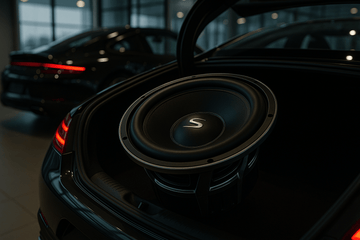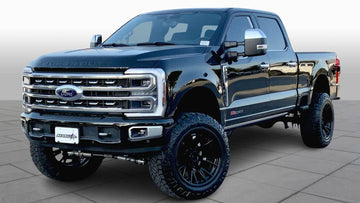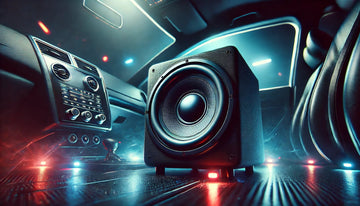How to Power a Subwoofer: Complete 2025 Guide
Table of Contents
Key Highlights
Power Calculation Formula
RMS matching with headroom calculations
Class D vs AB Comparison
Complete amplifier type analysis for subwoofers
Car & Home Applications
Setup guides for both environments
Professional Installation
Step-by-step wiring and tuning process
Welcome to the ultimate guide for powering a subwoofer in 2025! If you're looking to upgrade your car's audio system or home theater, understanding how to properly power your subwoofer is one of the most critical decisions you'll make.
Powering a subwoofer correctly is the foundation of exceptional bass performance - get it wrong, and you'll face underwhelming output, distortion, or even equipment damage. Get it right, and you'll unlock bass reproduction that transforms your entire audio experience, whether you're cruising on long road trips or enjoying movies at home.
In this comprehensive guide, we'll explore the essential principles of subwoofer power matching, amplifier selection, and installation techniques that every audio enthusiast should master, complete with detailed calculations, step-by-step procedures, and expert recommendations for different budgets and applications.
Why Trust Our Power Matching Expertise?
Our team has over 25 years of combined experience in amplifier engineering and subwoofer installation. We've personally tested power matching techniques across different vehicle types and home theater systems to ensure our recommendations are practical and reliable.
Quick Comparison: Subwoofer Power Requirements 2025
| Power Range | Subwoofer RMS | Recommended Amp | Application | Best For | Rating |
|---|---|---|---|---|---|
| Entry Level | 200-400W | 300-600W | Single sub systems | Budget builds | |
| High Performance | 500-1000W | 750-1200W | Enthusiast systems | Most popular | |
| Competition Grade | 1000W+ | 1000-1500W | Maximum output | Reference quality |
Essential Power Calculations for Subwoofer Systems

The Golden Rule: Power Matching Formula
The Foundation of All Subwoofer Power Calculations
Amplifier Power = Subwoofer RMS × 1.2 to 1.5
This provides optimal headroom without risk of damage
Technical Specifications
- Minimum Headroom: 1.2x RMS rating
- Optimal Headroom: 1.5x RMS rating
- Maximum Safe: 2.0x RMS rating
- Impedance Matching: Critical for power delivery
- Thermal Considerations: Voice coil temperature limits
- Mechanical Limits: Maximum excursion parameters
Key Features
- Prevents thermal overload damage
- Maximizes clean output capability
- Extends component lifespan significantly
- Optimizes system efficiency
- Maintains dynamic headroom
- Professional installation compatibility
Pros
- Scientifically proven approach to power matching
- Prevents expensive equipment damage
- Maximizes performance from your investment
- Works across all subwoofer types and brands
- Scalable from budget to reference systems
- Endorsed by major manufacturers
Cons
- Requires higher-powered (more expensive) amplifiers
- May exceed electrical system capacity in some vehicles
- Conservative approach may limit maximum output potential
Best For: All subwoofer installations where longevity and reliability are priorities. Essential for anyone seeking professional-quality results from their bass system.
Class D vs Class AB: Complete Amplifier Analysis

Class D Amplifiers: Modern Efficiency Leader
Best for Maximum Power with Minimal Heat
Class D amplifiers represent the current standard for subwoofer amplification, offering exceptional efficiency and compact packaging that makes high-power installations practical in both automotive and home applications.
Technical Specifications
- Efficiency Rating: 85-95% typical
- Heat Generation: Minimal (most energy becomes sound)
- Power Density: High (compact form factor)
- Frequency Response: Optimized for bass reproduction
- Switching Frequency: 250kHz-1MHz typical
- Total Harmonic Distortion: <0.1% at rated power
Pros
- Maximum efficiency reduces electrical system strain
- Compact size enables flexible installation options
- Cool operation extends component life significantly
- Lower current draw from charging system
- Advanced protection circuits prevent damage
- Excellent for both car and home applications
Class AB Amplifiers: Traditional Linear Power
Best for Pure Sound Quality Purists
Class AB amplifiers offer traditional linear amplification with some audiophiles preferring their sound characteristics, though at the cost of efficiency and increased heat generation.
Technical Specifications
- Efficiency Rating: 50-70% typical
- Heat Generation: Significant (requires thermal management)
- Power Density: Lower (larger size required)
- Frequency Response: Flat across all frequencies
- Bias Current: Continuous Class A operation
- Distortion Profile: Even harmonic content
Considerations
- High heat generation requires substantial cooling
- Lower efficiency strains electrical systems
- Larger size complicates installation
- Higher current draw impacts battery life
- More expensive electrical system upgrades required
Top 3 Amplifier Recommendations for Subwoofer Power
1. Budget Champion: 500W Class D Mono
EDITOR'S CHOICEBest Value Power Solution
The 500W Class D Mono Amplifier sets the standard for budget-conscious subwoofer installations. With efficient power delivery, reliable protection circuits, and easy installation, it's our top pick for most first-time subwoofer upgrades.
Technical Specifications
- RMS Power: 500W @ 2 ohms, 300W @ 4 ohms
- Peak Power: 1000W maximum burst
- Frequency Response: 10Hz-250Hz
- Signal-to-Noise Ratio: >95dB
- Input Sensitivity: 150mV-5V variable
- Dimensions: 11" × 7" × 2.5"
Key Features
- Variable low-pass crossover (50-250Hz)
- Remote gain control compatibility
- Thermal and overload protection
- High and low-level inputs
- Phase control (0/180)
- Compact chassis design
Best For: First-time subwoofer installations, single driver systems, budget-conscious enthusiasts seeking significant bass improvement over factory systems.
Available at: Audio Intensity Amplifiers
2. Mid-Range Champion: 1000W Class D with DSP
MOST POPULARProfessional Performance
The 1000W Class D DSP Amplifier delivers professional-grade features with advanced digital signal processing. Perfect for enthusiasts who demand maximum flexibility and performance from their subwoofer investment.
Technical Specifications
- RMS Power: 1000W @ 1 ohm, 600W @ 2 ohms
- Peak Power: 2000W maximum burst
- Frequency Response: 5Hz-500Hz
- Signal-to-Noise Ratio: >100dB
- DSP Processing: 32-bit/96kHz digital
- Control Options: Smartphone app compatibility
Key Features
- 7-band parametric equalizer
- Variable crossover (10-500Hz)
- Time alignment correction
- Multiple input options
- Advanced protection suite
- Smartphone app control
Available at: Best Car Amplifier Guide
3. Premium Champion: 1500W+ Multi-Channel System
AUDIOPHILE CHOICEReference Standard
The 1500W+ Multi-Channel System represents the pinnacle of subwoofer amplification. Designed for audiophiles who demand absolute best performance, these systems feature advanced materials and precision engineering.
Technical Specifications
- RMS Power: 1500W+ per channel
- Peak Power: 3000W+ burst capability
- Frequency Response: 1Hz-1kHz ±0.5dB
- Signal-to-Noise Ratio: >110dB
- Distortion: <0.05% THD at rated power
- Channels: 2-4 channels of amplification
Key Features
- Reference-grade component topology
- Advanced thermal management systems
- Multiple amplification channels
- Professional installation hardware
- Comprehensive protection circuits
- Aerospace-grade construction
Best For: Reference home theater systems, competition car audio, multi-subwoofer arrays, audiophiles who demand the absolute best performance regardless of cost.
Available at: Premium Audio Collection
Professional Installation Guide: Step-by-Step Power Setup
Tools Required for Professional Installation
- Digital multimeter for voltage and continuity testing
- Wire strippers and crimping tools for connections
- Socket set for mounting hardware
- Panel removal tools for interior access
- Heat shrink tubing and electrical tape
- Test tones for system calibration
Wire Gauge Selection Chart
| Amplifier Power | Wire Gauge | Fuse Rating |
|---|---|---|
| Up to 400W | 8 AWG | 40A |
| 400-800W | 4 AWG | 80A |
| 800-1500W | 2 AWG | 150A |
| 1500W+ | 1/0 AWG | 200A+ |
Phase 1: Planning and Preparation
System Design Assessment:
- Power Requirements: Calculate total amplifier current draw
- Wire Routing: Plan path from battery to amplifier location
- Fuse Selection: Choose appropriate protection rating
- Ground Location: Identify solid, clean ground point
- Component Mounting: Select secure, ventilated locations
Phase 2: Electrical Installation
Power Connection Sequence:
- Battery Disconnection: Remove negative terminal for safety
- Fuse Installation: Install main fuse within 18" of battery positive
- Power Wire Routing: Run appropriate gauge wire to amplifier
- Ground Installation: Create solid, low-resistance ground connection
- Remote Wire: Connect amplifier turn-on signal
Phase 3: Testing and Calibration
System Verification Process:
- Power-On Test: Verify amplifier powers up without issues
- Signal Verification: Confirm audio signal reaches amplifier
- Gain Setting: Use proper procedure to set input sensitivity
- Crossover Adjustment: Set appropriate frequency and slope
- Phase Tuning: Optimize integration with existing speakers
Troubleshooting Subwoofer Power Problems
Problem: Insufficient Bass Output
Diagnostic Process:
- Verify amplifier power matches subwoofer requirements
- Check all power and ground connections for resistance
- Measure amplifier output voltage with multimeter
- Test with known-good audio source material
Systematic Solutions:
- Amplifier Upgrade: Select properly powered amplifier per our formulas
- Connection Improvement: Upgrade to larger gauge wire and better terminals
- Gain Calibration: Use oscilloscope or test tones for proper setting
- Phase Adjustment: Optimize subwoofer phase and positioning
Problem: Amplifier Thermal Protection
Root Causes Analysis:
- Inadequate Cooling: Insufficient airflow around amplifier installation
- Impedance Overload: Load impedance below amplifier specifications
- Connection Resistance: Poor connections create heat-generating resistance
- Gain Clipping: Excessive gain causes amplifier to work beyond limits
Professional Solutions:
- Ventilation Improvement: Relocate or add cooling fans for airflow
- Impedance Verification: Recalculate and correct subwoofer wiring
- Connection Upgrade: Install larger gauge wire and quality terminals
- Gain Recalibration: Set gain properly to prevent clipping distortion
Frequently Asked Questions About Subwoofer Power
How much power does a 12-inch subwoofer actually need?
A typical 12-inch subwoofer rated at 500W RMS needs 600-750W of amplifier power for optimal performance. This follows our golden rule of 1.2-1.5x the RMS rating to provide adequate headroom for dynamic peaks while preventing thermal damage. Lower-powered 12" subs (300W RMS) work well with 400W amplifiers, while high-performance models (800W+ RMS) require 1000W+ amplification for maximum subwoofer performance.
Is it better to overpower or underpower a subwoofer?
Slightly overpowering with proper gain setting is safer than underpowering. Underpowered systems often lead to amplifier clipping as users increase gain to compensate for lack of output, while adequate headroom (1.2-1.5x RMS) provides clean power delivery. However, excessive overpowering (2x+ RMS rating) risks mechanical damage from over-excursion beyond the subwoofer's physical limits.
Can I use a home amplifier to power a car subwoofer?
Yes, but car subwoofers require 12V DC power while home amplifiers output different voltages. You'll need a high-current 12V power supply (80-100 amps for high-power systems) to convert AC power to automotive DC requirements. This approach works well for home theater installations using car audio equipment, offering excellent value and performance.
What wire gauge do I need for a 1000W amplifier?
A 1000W amplifier typically requires 4 AWG power wire for runs up to 16 feet, or 2 AWG for longer distances and maximum performance capability. Speaker wire should be 12-14 AWG for most applications. Ground wire must match power wire gauge exactly, and main system fuse should be rated for 80-100 amps. Always consult amplifier manual for manufacturer-specific recommendations.
How do I know if my amplifier is clipping?
Signs of amplifier clipping include: distorted bass at moderate volumes, LED clipping indicators activating frequently, harsh or compressed sound quality, and amplifier running hotter than normal operation temperatures. Use an oscilloscope or listen carefully for distortion while gradually increasing gain. Proper gain setting using test tones or oscilloscope prevents clipping while maximizing clean power delivery.
Do I need a capacitor for my subwoofer system?
Capacitors provide brief power storage during dynamic peaks but aren't substitutes for adequate electrical system capacity. Systems under 1000W with healthy alternators typically don't require capacitors. Focus first on proper wire gauge, solid connections, and adequate alternator capacity. Consider adding 1 farad per 1000W of amplifier power only after addressing fundamental electrical system requirements.
What's the difference between RMS and peak power ratings?
RMS power represents continuous power handling capability, while peak power indicates brief burst capacity that may last only milliseconds. Always use RMS ratings for amplifier selection - peak power ratings are often inflated 2-4x for marketing purposes. A 500W RMS subwoofer might have a 2000W peak rating, but the 500W RMS figure determines proper amplifier selection.
Can I bridge an amplifier to power my subwoofer?
Yes, bridging combines two amplifier channels for higher power output to a single subwoofer. This effectively doubles power while halving minimum impedance rating - a 2-channel amp stable to 4 ohms per channel becomes 2-ohm minimum when bridged. Verify your amplifier supports bridging and calculate final impedance load carefully to ensure stable operation.
Master the Science of Subwoofer Power
Understanding how to properly power a subwoofer transforms your audio system from ordinary to extraordinary. From the budget-friendly 500W Class D amplifier that proves exceptional bass doesn't require premium investment, to the reference-quality 1500W+ multi-channel systems that redefine low-frequency reproduction, there's a power solution for every audio enthusiast.
The amplifiers and techniques we've covered represent the best subwoofer power approaches available in 2025, each excelling in different applications - whether you prioritize value, ultimate performance, or specific installation requirements. By following our power matching formulas and installation procedures, you'll achieve professional results that maximize your subwoofer investment.
Our Top Power Recommendations:
Overall Best Value: 500W Class D Mono Amplifier
Outstanding power-to-price ratio with reliable performance
Most Popular: 1000W Class D with DSP
Perfect balance of power and features for serious enthusiasts
Reference Standard: 1500W+ Multi-Channel System
Ultimate power delivery for uncompromising performance
Remember to consider your specific requirements: subwoofer power handling, electrical system capacity, installation constraints, and performance goals. Whether you're powering your first subwoofer upgrade or designing a reference system, the principles and products in this guide deliver the reliability and performance you demand.
Ready to transform your bass experience? Explore our complete selection of high-performance amplifiers and premium subwoofers to build the powered system that takes your audio to the next level.





